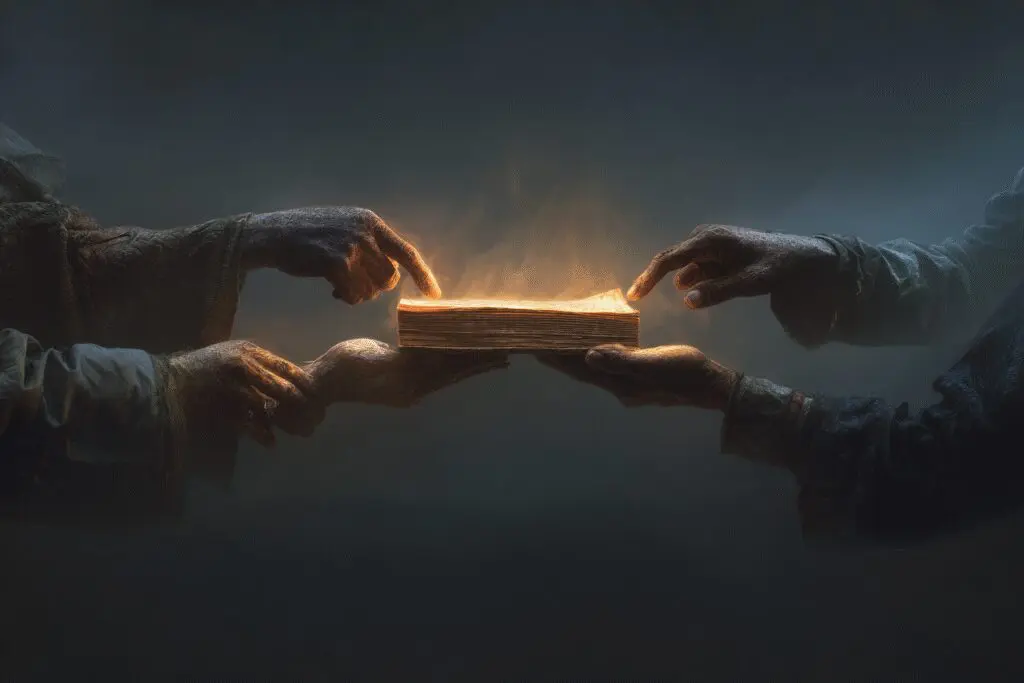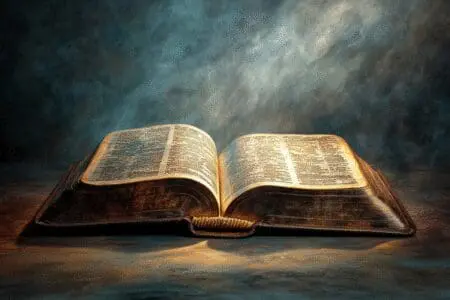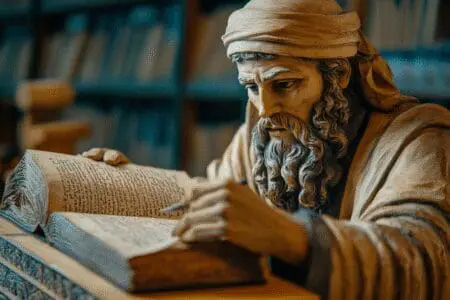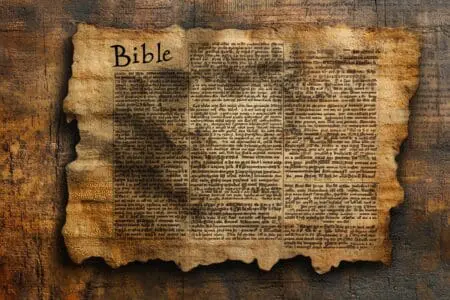I remember sitting in a stuffy church basement as a kid, flipping through the impossibly thin pages of a Gideon Bible. The book felt ancient, monolithic, like it had been dropped out of the sky in its current form—black leather cover, gold-leaf pages, and all. For a long time, I just assumed that’s how it was. A single book, written from start to finish. But the more I’ve looked into it, the more I’ve realized that couldn’t be further from the truth. The story of how we got the Bible isn’t about one book; it’s about a library, assembled over thousands of years by countless hands, full of arguments, revisions, and a staggering amount of human effort.
It’s a story that is far more fascinating, messy, and, frankly, more believable than the one I had in my head.
This isn’t a story about divine dictation. It’s about people. It’s about shepherds telling stories around a fire, scribes painstakingly copying scrolls in dusty rooms, scholars arguing late into the night about which texts truly belonged, and translators risking their lives to bring these words into a language ordinary people could understand. It’s a human story, from start to finish.
More in Bible Category
How Were the Books of the Bible Selected
Is Job the Oldest Book in the Bible
When Was Each Book of the Bible Written
Key Takeaways
- The Bible wasn’t written as a single book. It’s a collection of 66 separate books (for Protestants) written by many different authors across roughly 1,500 years.
- It started with oral tradition. For centuries, stories of creation, patriarchs, and laws were passed down verbally from generation to generation before ever being written down.
- Choosing the books was a long process. Church communities and leaders debated for centuries about which writings were authoritative and should be included in the canon, or the official collection. This wasn’t settled in a single meeting.
- Translation is a core part of the story. The Bible has been translated from its original Hebrew, Aramaic, and Greek through major historical versions like the Greek Septuagint and Latin Vulgate, eventually leading to English translators like Wycliffe and Tyndale who risked everything for the cause.
- We don’t have the original manuscripts. What we have are thousands of copies made by scribes over the centuries. The consistency between these copies is remarkable, but they are still copies made by human hands.
Where Did the Old Testament Even Come From?
Before a single word was written, there were stories. You have to picture a world without screens, without books, without even widespread literacy. History, culture, and faith were all passed down orally. Fathers taught their sons, mothers taught their daughters. They told the stories of Abraham’s journey, of Jacob’s wrestling match, of Moses and the exodus from Egypt. These weren’t just bedtime stories; they were the glue that held their identity together.
So, When Did They Start Writing It Down?
The shift from speaking to writing was a massive one, and it didn’t happen overnight. Most scholars believe the first parts of the Old Testament began to be written down somewhere around the time of King David and Solomon, maybe 1,000 years before Jesus. And they weren’t writing on paper. They used papyrus (a brittle plant-based material) and vellum (prepared animal skin). These were scrolls, not books.
Think about that for a second. The book of Isaiah wasn’t a chapter in your Bible; it was a massive, cumbersome scroll that you had to unroll to read. You couldn’t just flip to your favorite passage. This was a physical, deliberate act.
For a long time, scholars have talked about different sources that were eventually woven together to create the first five books of the Bible, the Torah. It’s just a theory, but it makes a lot of human sense. The idea is that you can see different writing styles and names for God that suggest at least four different sources were combined over time. It shows a process of editing and compiling, of people taking these sacred traditions and carefully fitting them together. It wasn’t one person in a room; it was generations of people.
Who Decided Which Scrolls Made the Cut?
By about 400 B.C., the scrolls we now know as the Old Testament were largely complete. A scribe named Ezra plays a huge role here. After the Jews returned from exile in Babylon, there was a deep need to gather their sacred texts and re-establish their identity. Ezra was instrumental in collecting these scrolls and teaching them as the authoritative Word of God.
But it still wasn’t a closed list. Different Jewish groups had slightly different collections. This brings us to a really important translation: the Septuagint. Around 250 B.C., in Alexandria, Egypt, a huge number of Jews only spoke Greek, the common language of the day. A project was launched to translate the Hebrew Scriptures into Greek. This translation included several books that aren’t in the Protestant Old Testament today—books we call the Apocrypha. It’s a perfect example of the human need to make scripture accessible, to meet people where they are.
The 400 Years of “Silence”
Between the end of the Old Testament and the beginning of the New, there’s a gap of about 400 years where no new scripture was written. But this was anything but a quiet time. The Romans conquered everything, the political landscape was a mess, and Jewish groups like the Pharisees and Sadducees were constantly arguing about how to live faithfully under occupation.
This period of turmoil and anticipation is the world Jesus was born into. It was a world desperate for a word from God.
And Then Came the New Testament
Just like the Old Testament, the New Testament didn’t start with writing. It started with a person: Jesus. He didn’t write a single book. He taught, he told stories, he lived a life, and he gathered a group of followers who were captivated by him.
For decades after his death and resurrection, the story of Jesus was primarily an oral one. The apostles traveled from town to town, telling people what they had seen and heard. The “gospel” was a spoken message, not a written text.
The First Things Written: Paul’s Letters
The very first books of the New Testament to be written weren’t the four Gospels. They were letters. A fiery, brilliant, and deeply passionate church planter named Paul was traveling the Roman Empire starting new Christian communities. And these communities were full of problems. They argued about food, they had questions about marriage, and they were confused about what would happen when Jesus returned.
Paul wrote letters to them to solve problems. He was doing remote pastoral care. He wasn’t sitting down thinking, “I’m going to write a book of the Bible.” He was writing to the real-life messes of the church in Corinth or the believers in Galatia. They were practical, personal, and urgent. They were collected and shared because other churches found his advice so valuable.
Why Are There Four Gospels?
It wasn’t until about 30 to 60 years after Jesus’s death that the Gospels—Matthew, Mark, Luke, and John—were written down. Why wait so long? Well, as the original eyewitnesses started to get old and die, the community felt a pressing need to preserve their testimony in a more permanent form.
Each Gospel was written for a slightly different audience, with a different emphasis.
- Mark is short, punchy, and action-packed. It’s likely the first one written, a raw and immediate account.
- Matthew was likely written for a Jewish audience, constantly connecting Jesus’s life to Old Testament prophecies.
- Luke, a doctor and a meticulous historian, wrote a more detailed, orderly account, also penning the book of Acts. You can find his version of the story in the British Library’s collection of sacred texts.
- John is completely different. It’s more philosophical and theological, offering a unique, personal portrait of Jesus.
The early church didn’t see these four accounts as a problem. They saw them as four different portraits of the same incredible person. Like getting four different witnesses to describe an event—each one gives you a richer, fuller picture.
The Big Debate: Forming the Canon
This is the part of the story that really fascinates me. How did we get from a pile of scrolls and letters to a finalized New Testament? It was not a neat and tidy process. For centuries, there were debates.
Around the 2nd century, a lot of other “gospels” started popping up, like the Gospel of Thomas and the Gospel of Peter. Some of these, known as Gnostic gospels, presented a very different version of Jesus—one who shared secret knowledge, not one who died for the sins of the world. The church leaders had to figure out what was authentic and what wasn’t. They were asking the same questions we would. How do we know this is true?
They developed a set of common-sense criteria.
It wasn’t a formal checklist, but more of a shared understanding that emerged over time.
- Was it written by an apostle or someone close to an apostle? They wanted a direct link to the eyewitnesses.
- Was it universally accepted by churches everywhere? A letter used only by one church in a corner of the empire was less likely to be seen as authoritative.
- Did it align with the core faith that had been passed down? It had to be consistent with what they already believed about Jesus from the trusted traditions.
This wasn’t decided in a single smoke-filled room. It was a consensus that grew over a couple of hundred years. Leaders like Irenaeus and Athanasius made lists of books they considered scripture, and over time, their lists started to look more and more alike. Church councils, like the Council of Laodicea (363 A.D.) and Carthage (397 A.D.), didn’t so much decide the canon as they did confirm what had already become the common practice in the vast majority of churches. They were recognizing the library, not creating it.
Copyists, Translators, and Revolutionaries
So the list of books was settled. But that’s not the end of the story. Remember, there was no printing press. For over a thousand years, the Bible was preserved by scribes who copied every single letter by hand.
I once tried to copy a single page from a book, word for word. I made three mistakes in the first two paragraphs. Now imagine doing that for your entire life, with the pressure of preserving a sacred text. These scribes were incredibly dedicated. And because we have discovered thousands of manuscripts from different times and places, we can cross-reference them and be incredibly confident about the contents of the original text, even if we don’t have the very first documents themselves. The variations are overwhelmingly minor—things like spelling differences or a swapped word order—with no major doctrine being affected.
Taking the Bible to the People
As the Roman Empire shifted, Greek fell out of common use and Latin became the dominant language. Around 400 A.D., a scholar named Jerome translated the entire Bible into Latin. This version, the Vulgate, became the official Bible of the Western church for the next 1,000 years. Once again, it was a human effort to make sure people could actually read the words.
But then, something happened. The church leadership in the Middle Ages began to resist the idea of translating the Bible any further. The Latin Vulgate was the only version they authorized, but by this point, ordinary people didn’t speak Latin. The Bible had become a book for priests and scholars, not for farmers and blacksmiths.
This is when the real heroes of translation emerge.
- John Wycliffe (1380s): An English scholar who believed it was a crime to keep the Bible from ordinary people. He supervised the first-ever complete translation of the Bible into English, all copied by hand from the Latin Vulgate. The church was furious. They declared him a heretic, and decades after his death, they dug up his bones, burned them, and threw the ashes in a river.
- William Tyndale (1520s): The invention of the printing press changed everything. Tyndale was a brilliant linguist who was determined to translate the Bible into English from the original Greek and Hebrew, not just Latin. The church authorities forbade it, so he fled to Germany and smuggled his printed New Testaments back into England. His translation was so good, so powerful and poetic, that the vast majority of the King James Version is taken directly from his work. For his “crime,” Tyndale was eventually captured, strangled, and burned at the stake. His last words were reportedly, “Lord! Open the King of England’s eyes.”
His prayer was answered. Just a few years later, King Henry VIII, for his own political reasons, authorized an English Bible.
The King James Version and Beyond
By the early 1600s, there were several English translations floating around, and it was causing division. King James I commissioned a new translation with the goal of unifying the church. He assembled a committee of about 50 of the best scholars in the land, and they spent years perfecting a translation that was both accurate and beautiful. The result, in 1611, was the King James Version, a masterpiece of English prose that shaped the language for centuries.
But language changes. That’s why today we have dozens of modern translations. It’s not because the old ones were necessarily “wrong,” but because words change their meaning. Translators are still doing the same work Jerome and Tyndale did: trying to bridge the gap between the ancient world and our own, to bring the text to life for people today. They have to make tough choices. Do you translate word-for-word (more literal) or thought-for-thought (more readable)? Both are valid approaches, which is why having different translations can actually be a good thing.
The journey of the Bible is a powerful testament to the human desire to preserve and understand what we hold sacred. It’s a story of courage, scholarship, and sometimes, bitter conflict. It wasn’t dropped from heaven. It was fought for, copied, translated, and passed down through the hands of countless flawed but dedicated people. And knowing that makes the book on my shelf feel less like an untouchable relic and more like a living, breathing library, built for us.
Frequently Asked Questions – How We Got the Bible

How did the invention of the printing press influence the distribution of the Bible?
The printing press, invented in the 15th century, allowed Bibles to be produced quickly and cheaply, which helped spread God’s Word widely and played a major role in the Reformation and making the Bible available to many people.
What is the significance of the process called ‘canon’ in how we got the Bible?
The canon is the process by which the church recognized which writings were truly inspired by God, based on rules like apostolic origin, widespread acceptance, and doctrinal consistency, rather than voting to create new texts.
Why was the Greek translation of the Hebrew Bible, the Septuagint, so important?
The Septuagint, translated around 250 BC by 72 Jewish scholars, was important because it made the Scriptures accessible to Greek-speaking Jews and early Christians, so they could understand God’s Word.
What role did the Masoretes play in preserving the Hebrew text?
The Masoretes, Jewish scribes from about 700 to 1000 AD, carefully copied the Hebrew texts, using a system to avoid mistakes, ensuring the Hebrew Bible remained almost unchanged over centuries.




